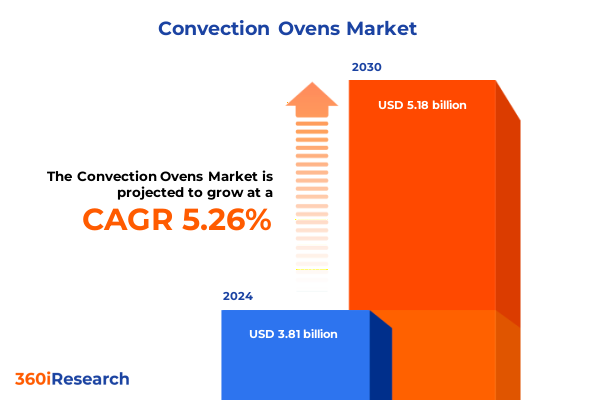The Convection Ovens Market size was estimated at USD 3.81 billion in 2024 and expected to reach USD 4.02 billion in 2025, at a CAGR 5.26% to reach USD 5.18 billion by 2030.

Introduction: Market Landscape for Convection Ovens
As the commercial foodservice and residential culinary sectors embrace advanced cooking technologies, convection ovens are emerging as essential tools for efficiency, consistency, and innovation. With rising demand from restaurants, bakeries, and home chefs who seek precise temperature control and faster cooking times, manufacturers are investing in next-generation designs that integrate digital controls, energy-saving features, and modular configurations. Recent shifts in consumer preferences-favoring versatility, user-friendly interfaces, and sustainable operation-are accelerating adoption. This evolving landscape is further shaped by competitive pressures to reduce operating costs, streamline kitchen workflows, and deliver high-quality results. Whether in an industrial bakery producing thousands of loaves daily or a residential setting where culinary experimentation thrives, convection ovens are redefining how heat is transferred to food. In this context, understanding the drivers, challenges, and opportunities within the convection oven market is critical for stakeholders looking to capitalize on growth, manage regulatory headwinds, and maintain a competitive edge.
Transformative Shifts Reshaping the Convection Oven Industry
The convection oven industry is undergoing transformative shifts driven by technological breakthroughs and changing stakeholder expectations. Smart connectivity has become a cornerstone, enabling remote monitoring, recipe automation, and predictive maintenance through cloud-based platforms and voice assistant integration. Concurrently, there is a heightened emphasis on sustainability: energy-efficient heating elements and auto-cleaning systems reduce utility consumption and water usage, responding to stricter environmental regulations. Customization has also risen in prominence, with manufacturers offering customizable control interfaces and modular configurations tailored to bakery ovens, rotisserie, and combi functions. Supply chain digitization-leveraging IoT sensors and blockchain tracking-has enhanced traceability of raw materials like stainless steel, aluminum, and enamel components, mitigating risk and ensuring quality. Additionally, the rise of professional chefs, catering services, and institutional users is driving demand for commercial grade convection ovens capable of high throughput. These shifts collectively underscore a market that is more agile, data-driven, and sustainability-oriented than ever before.
Cumulative Impact of United States Tariffs in 2025
The implementation of new U.S. tariffs in 2025 has had a cumulative impact on both imported convection ovens and their components. Increased duties on steel and aluminum have raised production costs for domestic manufacturers while also affecting imported finishes such as enamel and stainless steel door assemblies. Section 301 measures targeting certain foreign-made models have led to higher price tags for countertop and built-in wall ovens sourced from overseas suppliers. As a result, end users are experiencing cost pass-through, prompting some to delay purchases or explore mid-range and economy price‐range segments. Distributors and OEMs have responded by diversifying their sourcing strategies, shifting part of procurement to regions with preferential trade agreements and reinvesting in local fabrication of heating elements and digital control modules. Although initial supply chain disruptions caused shipment delays, manufacturers with established regional production hubs reported faster recovery, emphasizing the value of a balanced global footprint. Overall, the 2025 tariffs have accelerated reshoring efforts, stimulated innovation in material selection, and intensified focus on high-value offerings.
Key Segmentation Insights Across Product, End User, and Features
Insight into market segmentation reveals the nuanced demand patterns across multiple dimensions. Based on type, built-in wall convection ovens-offered in both single and double wall variants with side-by-side or stacked configurations-are favored in premium residential and institutional settings, while commercial grade ovens including bakery, combi, and rotisserie ovens address high-volume needs. Countertop and floor model units appeal to space-constrained kitchens or mobile applications. When categorized by heating method, electric units dominate in urban locales with reliable power grids, gas convection ovens are preferred for rapid heat response in large kitchens, and steam ovens-available in direct and indirect configurations-cater to precision baking and moisture-sensitive foods. End-user segmentation highlights industrial bakeries, small bakery shops, hospitals, schools, restaurants, professional chefs, catering services, and residential buyers, each requiring tailored performance and hygiene features. Size differentiation from compact to large influences installation decisions in limited kitchens versus large‐scale facilities. Control types span mechanical knobs for basic operations, digital interfaces for programmable cooking, and smart controls integrating apps and voice assistants. Materials such as aluminum, enamel, and stainless steel determine durability and cost. Portability options range from fixed installations to portable units, and price bands cover economy through premium models. Key features including auto-cleaning, energy efficiency, multi-mode cooking, and smart connectivity further shape product selection, while user ratings offer social proof driving purchase decisions.
This comprehensive research report categorizes the Convection Ovens market into clearly defined segments, providing a detailed analysis of emerging trends and precise revenue forecasts to support strategic decision-making.
- Type
- Heating Method
- End-User
- Size
- Control Type
- Material
- Portability
- Price Range
- Key Features
- User Rating
Key Regional Insights Driving Adoption and Innovation
Regional dynamics illustrate distinct growth trajectories. In the Americas, strong investment in commercial kitchens and residential renovation trends support demand for mid-range and premium convection ovens. Suppliers in North America benefit from reshoring efforts and favorable domestic manufacturing incentives. In Europe, Middle East & Africa, diverse regulatory frameworks drive demand for energy-efficient and auto-cleaning models, with EU energy labeling standards pushing manufacturers toward low‐consumption designs. Rapid urbanization in the Middle East has increased demand for commercial grade ovens in hospitality projects. Asia-Pacific stands out for its expanding foodservice infrastructure, especially in China, India, and Southeast Asia, where institutional procurement for schools and hotels is accelerating. Manufacturers in this region leverage cost-effective production of components such as digital controls and heating elements, supporting competitive pricing. Across all regions, evolving food safety regulations, sustainability mandates, and digital adoption create both challenges and opportunities for market participants.
This comprehensive research report examines key regions that drive the evolution of the Convection Ovens market, offering deep insights into regional trends, growth factors, and industry developments that are influencing market performance.
- Americas
- Asia-Pacific
- Europe, Middle East & Africa
Key Company Insights: Market Leaders and Specialized Innovators
The competitive landscape features a mix of global OEMs, regional specialists, and emerging disruptors. Leading original equipment manufacturers such as Alto-Shaam, Inc. and Middleby Corporation are distinguished by extensive R&D budgets and comprehensive product portfolios covering bakery, combi, and rotisserie solutions. Electrolux AB, Thermcraft, Inc., and UNOX SpA emphasize energy efficiency and smart connectivity, while European process plant providers like European Process Plant Ltd. and Star Progetti Tecnologie Applicate S.p.a. focus on modular, turnkey installations. In Asia, Guangzhou BakeStar Machinery Co., Ltd. and Shanghai Yiheng Scientific Instruments Co., Ltd. leverage cost-efficient manufacturing for steam and electric models, whereas companies such as DKSH Holding Ltd. and Naru Equipment lead regional distribution networks. Heritage brands including Blue Seal Limited, Moffat Group Pty Ltd, and WIESHEU GmbH maintain strong footholds in institutional markets, and specialty providers like Blizzard and Heller Industries, Inc. differentiate through custom fabrication. Service-oriented suppliers such as Falcon Foodservice Equipment, Duke Manufacturing, and JJ Martin Ltd. complement hardware offerings with maintenance and training programs. Overall, the market is characterized by strategic partnerships, product innovation, and expansion into adjacent service ecosystems.
This comprehensive research report delivers an in-depth overview of the principal market players in the Convection Ovens market, evaluating their market share, strategic initiatives, and competitive positioning to illuminate the factors shaping the competitive landscape.
- Alto-Shaam, Inc.
- Blizzard
- Blue Seal Limited
- Buffalo Ovens
- DKSH Holding Ltd.
- Duke Manufacturing
- Electrolux AB
- ELOMA GmbH
- Empire Supplies
- European Process Plant Ltd.
- Falcon Foodservice Equipment
- Guangzhou BakeStar Machinery Co.,Ltd
- Guangzhou Hongling Electric Heating Equipment Co., Ltd.
- Hatco Corporation
- Heller Industries, Inc.
- Illinois Tool Works, Inc.
- JJ Martin (Catering Appliance Superstore) Ltd
- Middleby Corporation
- Moffat Group Pty Ltd
- Naru Equipment
- Shanghai Yiheng Scientific Instruments Co., Ltd.
- Star Progetti Tecnologie Applicate S.p.a.
- Thermcraft, Inc.
- UNOX SpA
- WIESHEU GmbH
Actionable Recommendations for Industry Leaders
To navigate the evolving landscape and sustain growth, industry leaders must adopt a proactive strategy. Invest in smart control development and voice assistant integration to meet rising demand for IoT-enabled cooking solutions. Expand energy-efficient product lines and secure compliance with emerging environmental regulations by incorporating auto-cleaning and steam-convection technologies. Diversify supply chains to mitigate tariff impacts, leveraging regional manufacturing hubs and alternative materials such as aluminum and enamel. Enhance after-sales support through digital maintenance platforms and virtual training programs for professional chefs and institutional clients. Tailor marketing efforts to distinct segments-highlighting compact designs for residential users, high-throughput capabilities for industrial bakeries, and modular installations for catering services. Forge partnerships with software providers to deliver recipe libraries and predictive analytics, strengthening customer loyalty. Finally, conduct regular market intelligence reviews to detect shifts in end-user preferences and regional policy changes, ensuring swift adaptation and sustained competitive advantage.
Explore AI-driven insights for the Convection Ovens market with ResearchAI on our online platform, providing deeper, data-backed market analysis.
Ask ResearchAI anything
World's First Innovative Al for Market Research
Conclusion: Charting a Sustainable, Tech-Driven Future
The convergence of digital integration, sustainability imperatives, and supply chain resilience is redefining the convection oven market. While 2025 tariff measures have introduced cost pressures, they have also catalyzed reshoring, innovation in material sourcing, and a sharper focus on high-value product segments. Leading players that embrace smart controls, energy-efficient designs, and robust after-sales ecosystems will solidify their market positions. At the same time, regional nuances-from North America’s manufacturing incentives to Asia-Pacific’s foodservice expansion and EMEA’s regulatory rigor-underscore the need for a tailored approach across geographies. By leveraging segmentation insights and forging strategic partnerships, manufacturers and distributors can unlock new revenue streams and drive long-term growth in both commercial and residential sectors.
This section provides a structured overview of the report, outlining key chapters and topics covered for easy reference in our Convection Ovens market comprehensive research report.
- Preface
- Research Methodology
- Executive Summary
- Market Overview
- Market Dynamics
- Market Insights
- Cumulative Impact of United States Tariffs 2025
- Convection Ovens Market, by Type
- Convection Ovens Market, by Heating Method
- Convection Ovens Market, by End-User
- Convection Ovens Market, by Size
- Convection Ovens Market, by Control Type
- Convection Ovens Market, by Material
- Convection Ovens Market, by Portability
- Convection Ovens Market, by Price Range
- Convection Ovens Market, by Key Features
- Convection Ovens Market, by User Rating
- Americas Convection Ovens Market
- Asia-Pacific Convection Ovens Market
- Europe, Middle East & Africa Convection Ovens Market
- Competitive Landscape
- ResearchAI
- ResearchStatistics
- ResearchContacts
- ResearchArticles
- Appendix
- List of Figures [Total: 36]
- List of Tables [Total: 774 ]
Call-To-Action: Reach Out to Ketan Rohom for the Complete Market Research Report
For an in-depth analysis of market trends, competitive positioning, and strategic recommendations in the global convection oven industry, contact Ketan Rohom, Associate Director, Sales & Marketing. Gain access to comprehensive data, expert interpretation, and actionable insights to guide your next strategic move and capitalize on emerging opportunities.

- How big is the Convection Ovens Market?
- What is the Convection Ovens Market growth?
- When do I get the report?
- In what format does this report get delivered to me?
- How long has 360iResearch been around?
- What if I have a question about your reports?
- Can I share this report with my team?
- Can I use your research in my presentation?




